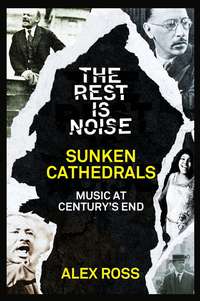
Полная версия
The Rest Is Noise Series: Beethoven Was Wrong: Bop, Rock, and the Minimalists
Ingrained in Harrison’s personality was a love of musical merriment, of hummable song and rollicking dance. He managed to assimilate these diverse strains into forms of Baroque poise and precision; his favorite composer was Handel. “Use only the essentials,” Schoenberg once said to his pupil. Harrison’s career was a creative misinterpretation of that remark; it gave him permission to vacate the overcrowded city space of modern music and to camp out in a desert landscape of long drones and lulling patterns.
As for Cage, he found the seeds for many of his most extreme inspirations on the West Coast. Cowell passed along his cherished ideas about flexibility of form and the interchangeability of music and noise. Cage took Cowell’s classes on non-Western music in New York in 1934 and drove across the country with him at the end of that year; American music was never the same afterward. Harrison helped Cage refine his writing for percussion; the two men organized annual concerts in the San Francisco Bay Area starting in 1939. The California spirit persists in the music that Cage wrote after moving permanently to New York—notably in the string-of-pearl sounds of the prepared-piano pieces and in the “nearly stationary” textures of the String Quartet in Four Parts.
Although Cage avoided tonality and repetition in his music from 1950 onward, he hovered over the radical end of American music as a liberating spirit. He had done the preliminary work of dismantling the European “vogue of profundity,” as he called it. In 1952, he scandalized a crowd at Black Mountain College by saying that Beethoven had misled generations of composers by structuring music in goal-oriented harmonic narratives instead of letting it unfold moment by moment. At a New York gathering, he was heard to say, “Beethoven was wrong!” The poet John Ashbery overheard the remark, and for years afterward wondered what Cage had meant. Eventually, Ashbery approached Cage again. “I once heard you say something about Beethoven,” the poet began, “and I’ve always wondered—” Cage’s eyes lit up. “Beethoven was wrong!” he exclaimed. “Beethoven was wrong!” And he walked away.
Cage’s definitive refutation of Beethoven came in the form of an epic, almost daylong performance of Erik Satie’s piano piece Vexations. The original score is only a page long and would normally take just a minute or two to play, but at the top appears this instruction: “In order to play this motif 840 times, one would have to prepare oneself in advance, and in the utmost silence, through serious immobilities.” Cage took this sentence at face value, and, on September 9 and 10, 1963, at the Pocket Theatre in New York, he presented Vexations complete. A team of twelve pianists played from 6:00 p.m. until 12:40 p.m. the following day. The New York Times responded by sending a gang of eight critics to cover the event, one of whom ended up performing. In the audience for part of the time was Andy Warhol, who remembered the experience when he made an eight-hour film of the Empire State Building the following year.
The venue was equipped with a time clock, which patrons punched on entering and leaving. Listeners were reimbursed five cents for each twenty minutes they spent in the hall. Those who saw the entire performance received a twenty-cent bonus. Karl Schenzer, an off-Broadway actor, was the only one to get a full refund, having sat in the hall for nearly nineteen hours. “I feel exhilarated, not at all tired,” Schenzer told the Times. “Time? What is time? In this music the dichotomy between various aspects of art forms dissolves.”
Feldman
It was after a New York Philharmonic performance of Anton Webern’s Symphony, on January 26, 1950, that John Cage met a six-foot-tall, nearly three-hundred-pound Jewish guy named Morton Feldman. Both men had walked out of Carnegie Hall early—according to Feldman, because they were dismayed by the hostile response that Webern’s music had inspired in Philharmonic listeners; according to Cage, because they wanted to avoid hearing Rachmaninov’s Symphonic Dances, which ended the program. When their paths crossed by the door, Feldman turned to Cage and asked, “Wasn’t that beautiful?” A lifelong friendship began.
Конец ознакомительного фрагмента.
Текст предоставлен ООО «ЛитРес».
Прочитайте эту книгу целиком, купив полную легальную версию на ЛитРес.
Безопасно оплатить книгу можно банковской картой Visa, MasterCard, Maestro, со счета мобильного телефона, с платежного терминала, в салоне МТС или Связной, через PayPal, WebMoney, Яндекс.Деньги, QIWI Кошелек, бонусными картами или другим удобным Вам способом.








